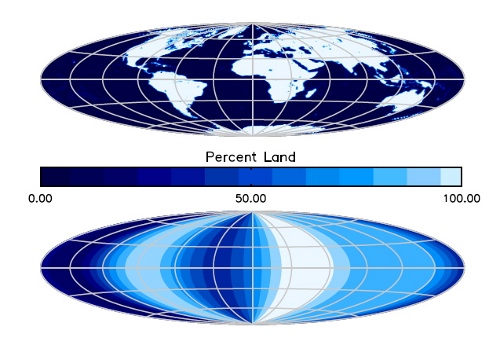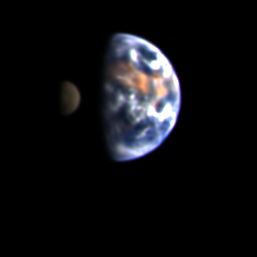Anyone who thought the Deep Impact mission was over when the spacecraft drove an impactor into comet Tempel 1 some four years ago has been given a lesson in the strategy of extended missions. Now heading for a flyby of comet Hartley 2 (late in 2010), Deep Impact is also doing yeoman work in the study of extrasolar planets. That phase of the mission is called Extrasolar Planet Observations and Characterization (EPOCh), but the spacecraft housing both investigations is now referred to as EPOXI.
If the acronyms can be confusing, the latest news from EPOXI is straightforward, and encouraging. A paper slated for summer publication in the Astrophysical Journal reports on the spacecraft’s observations of our own planet, made in 2008 when it was between 17 and 33 million miles from Earth. The idea was to tune up our capabilities at observing distant planets, using spectral information to map the distribution of continents and oceans. EPOXI’s High Resolution Imager thus set up a trial of Earth’s changing light as the planet rotates.

Image: Top panel: a normal map of Earth, made by earthlings who live here. Lower panel: An “Alien Map” of Earth, made from the EPOXI data after collapsing it to a single pixel. This is the kind of map that we should be able to make for Earth-like extrasolar planets, to reveal that they have oceans and continents like our home world. Credit: NASA/Drake Deming.
EPOXI studied Earth’s light in two separate 24-hour observational periods covering seven bands of visible light. Small deviations in the average color caused by surface features and clouds rotating in and out of view displayed two dominant colors, one reflective at red wavelengths, the other at shorter blue wavelengths. Mapping the changes over the 24-hour period allowed the scientists to compare what they were seeing with Earth’s actual oceans and continents. The upshot: It should be possible to pick out oceans on distant exoplanets.
The technique will obviously be superseded by future space instruments, but what the researchers have found is usable and could aid in the construction of later telescopes. Says Drake Deming (NASA GSFC and a co-author of the paper):
“A spectrum of the planet’s light that reveals the presence of water is necessary to confirm the existence of oceans. Finding the water molecule in the spectrum of an extrasolar planet would indicate that there is water vapor in its atmosphere, making it likely that the blue patches we were seeing as it rotates were indeed oceans of liquid water. However, it will take future large space telescopes to get a precise spectrum of such distant planets, while our technique can be used now as an indication that they could have oceans.”

It’s worth pointing out that the maps flowing out of the EPOXI data are sensitive only to the East-West positions of oceans and continents, and the data were taken when the spacecraft was directly above the equator. That, says Nicolas Cowan (University of Washington), sets up an inherent limitation in terms of viewing geometry. “We could erroneously see the planet as a desert world if it had a nearly solid band of continents around its equator and oceans at its poles.”
Image: the Earth-Moon system is seen with the Moon beginning its transit in front of Earth. It was taken on May 29, 2008 through three filters: blue, green and orange, centered at 450, 550 and 650 nm respectively, while the spacecraft was 0.33 AU (49,367,340 km and 30,675,43 miles) from Earth. Credit: NASA/JPL-Caltech/UMD/GSFC.
The things you can do by massaging a few pixels! Finding liquid water on an extrasolar planet in the habitable zone of its star would tell us we had located a potentially living world. Now it’s a matter of getting next-generation instruments into space that can return actual images of planets as small as Earth. When we have them in position, the varying light of that pale blue dot could be our first indication of success at finding an analog to our planet.
The paper is Cowan et al., “Alien Maps of an Ocean-Bearing World,” accepted for publication in the Astrophysical Journal and available online.


I never cease to be amazed over how smart, clever researchers can exceed our expectations with signal processing. Fascinating and promising for follow up on any close by Kepler discoveries.
Since we tend to select for exoplanets whose orbital planes are aligned with our instruments, the orientation of the orbital plane will be known, and it is probable that the rotation axis is more or less normal to that plane, we may be ok to assume we get an equatorial view using this technique.
I think we need more of these self-referential type missions. We take alot for granted in regards to SETI programs, considering we don’t even really *know* how our own radio or signal footprint appears from an objective perspective light years away. I heard the SETI faq claims our radio signals should be able to be picked up 10,000 ly away (once they’ve had enough time). Hence the reasoniong goes that we should be able to pick up similar signals. I dont really think thats a logical argument, when we have never even been in interstellar space, and the Voyager mission has caused surprises enough just at the heliosphere.
What if the fermi paradox is based on a false assumption?
Off the top of my head, I think the 10,000 ly figure is for communication between the Arecibo radio telescope and an alien equivalent. Ordinary alien radio leakage equivalent to Earth’s would be much more difficult (maybe impossible) to detect, even from a planet as close as Alpha Centauri. Current SETI searches seem to be based on the hope that alien civilizations are deliberately trying to get our attention, or else are generating extremely powerful signals for their own purposes.
The limitation mentioned regarding the hypothetical band of land around the equator is interesting, since I believe at several points in earth’s past there was a large equator straddling ocean. Earth observed at those time points by this method would have come across as much more of a pure ocean world.
The Earth and Moon as Seen from Mars
http://www.spaceref.com/news/viewsr.html?pid=32587
“The HiRISE instrument would make a great backyard telescope for viewing Mars, and we can also use it at Mars to view other planets, such as Jupiter.
This is an image of Earth and the Moon, acquired at 5:20 a.m. MST on 3 October 2007, at a range of 142 million kilometers, which gives the HiRISE image a scale of 142 km/pixel and an Earth diameter of about 90 pixels and a Moon diameter of 24 pixels.”
Book Review: From Jars to the Stars – How Ball Came to Build a Comet-Hunting Machine
October 17, 2010
Book Reviews
From Jars to the Stars – How Ball Came to Build a Comet-Hunting Machine by Todd Neff; Earthviewmedia; Denver, Colorado; $24.95 (trade paperback); 2010.
Here’s a fascinating book that’s perfect for reading as NASA’s Deep Impact/EPOXI spacecraft makes a breathtaking flyby of Comet Hartley 2 on November 4th.
The award-winning author has done a masterful job in telling the story that there’s more to space exploration than space and exploration – it’s the people! Neff has captured the dedication and creativity of engineers, designers and others – the collective enterprise of imagineers who make space exploration happen.
Full information here:
http://spacecoalition.com/blog/book-review-from-jars-to-the-stars-%e2%80%93-how-ball-came-to-build-a-comet-hunting-machine